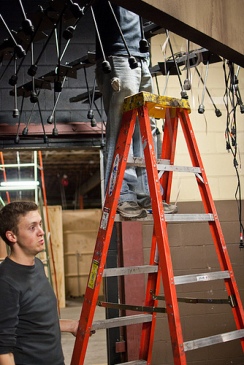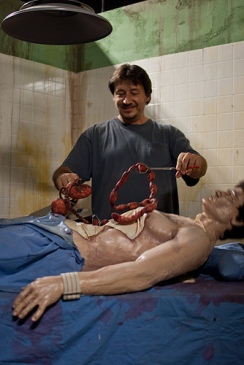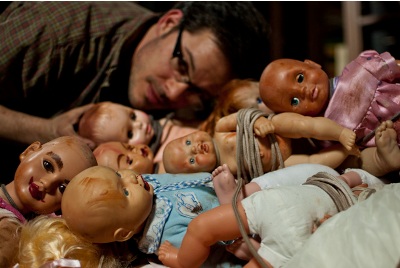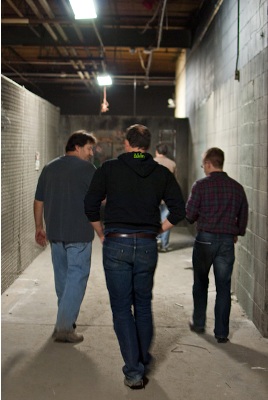The Building of Fear City (Part I)
By Alexander Hough in News on Oct 12, 2011 4:10PM
On October 1, Fear City, Chicagoland’s latest haunted house, opened its doors to the public. The night was briskly autumnal and the chill seeped through the front entrance into the wide, dimly-lit holding area. White Zombie’s “Thunderkiss ‘65” played loudly over the speakers. I was shivering slightly, though from neither the temperature nor the subwoofers’ rumblings; I was nervous about going through the $1 million, 32-room haunted house designed and constructed by 100 of Chicago’s most experienced film, television, and theater professionals.
I had been visiting Fear City since it was just an empty factory, but I hadn’t been in one week - an eternity in Fear City’s construction schedule - and, more importantly, I hadn’t seen it in full motion, with all the lighting, sound, and special effects, and the 54 actors creeping through the 40,000-square-foot haunt.
As I watched a loop of unsettling video clips play on several televisions behind a chain-link fence, a bald, thickset man wearing large black rubber gloves and a gas mask strode up to me and just stared. I was saved by a towering, Afro-ed woman clad in little more than lingerie, her enormous cleavage sitting above my eye level. She made a sexually suggestive remark that still has me blushing days later, then took my hand and led me to the first door. I swallowed hard and stepped into Fear City.
From a Victoria’s Secret Shoot, It Emerged…
Fear City is the brainchild of Jim Lichon and Chuck Grendys, veterans of Chicago’s production design scene. Raised in Portage Park, Lichon, 36, began professional property master work with local theaters while studying at a South Side community college. When he was 21, he moved to New York to work for Broadway touring companies, eventually growing dissatisfied with what he felt were the misplaced priorities of a more corporate atmosphere. After returning to Chicago, he spent six years as Steppenwolf’s prop master before taking the same position at Columbia College. During his second year at Columbia, he began working at Harpo Studios and, in 2007, moved there full-time, eventually rising to become The Oprah Winfrey Show’s head set decorator.
Grendys, 51, wound up in the field more by happenstance. Grendys grew up in Glenview, the son of the owner of Black Steer Provision, a meat-packing company on Fulton Street. He left Southern Illinois University after one year to work for his father, but took a job with a rival company when his father informed Grendys he was selling the business and retiring. In 1986, he received a call from a neighbor, who was working on The Untouchables, saying they were short on carpenters. Grendys, despite knowing nothing about the film industry or carpentry, immediately took a week off from his job. “I wanted to see what the movies were like. My friend was telling me, ‘We just did Blues Brothers, we just did this, we did that.’ It was so cool. They were making tons of money.” On Grendys’s second day, he worked on the post office set where Eliot Ness makes his first raid. Director Brian de Palma was so impressed that he made Grendys’s team the top crew for the remainder of production. Grendys, then 28, quit his job at the meat company and spent the next 33 weeks working on the set.
Other movies followed - Adventures in Babysitting, Midnight Run, Poltergeist III - and when that work slowed, Grendys moved to TV commercials (he estimates he has done 50-60 Michael Jordan spots). In 1995, he started Big City Sets, which builds sets and all manner of other items - for instance, Lady Gaga’s people called Grendys to build a giant gold shoe to serve as a keyboard perch for her January 2011 appearance on Oprah.
Lichon and Grendys met in June 2010 during filming for a Michael Bay Victoria’s Secret commercial. Lichon was using the summer lull in Oprah’s production schedule to work as the shoot’s set decorator. Grendys’s company had built many of the sets. While chatting during the shoot’s downtime, they discovered their mutual background in Halloween diversions.
Lichon worked on professional haunted houses as a teenager, helping with a small house at Ford City Mall, Hades Haunted House, Screamfest, and a house at the Museum of Science and Industry. Grendys, a Halloween enthusiast who decks out his house with customized, personally crafted decorations every October, helped build a haunted trail for his tight-knit Gurnee community five years ago. The trail, instantly popular, was repeated over the next two years, and became increasingly elaborate, as well as increasingly time-consuming, which forced Grendys to call it quits.
Neither Lichon nor Grendys remembers who introduced the idea of collaborating on their own haunted house, but once broached, plans for Fear City quickly snowballed. Each saw it as an irresistible opportunity to use their extensive production experience in a setting that afforded them complete creative control. The project would have only two limits. The first was money. Between Lichon and Grendys’s seed money and additional funding from private investors and advertising revenue, they amassed a sufficient budget. The second was time. As the owner of his own business, Grendys had flexibility. Lichon, however, was normally tied to the rigorous schedule of Harpo Studios. Fortunately, the recent business decisions of Oprah Winfrey provided an opening for Fear City’s inception.
Quoth Oprah: Nevermore
On November 19, 2009, Oprah Winfrey announced that the next season of The Oprah Winfrey Show, its 25th, would be its last. Although official announcements about the employment status of Harpo Studios’ workers were limited in number and scope, it was a common presumption among the staff that there would be a reduction in the volume of work. Although Harpo Studios was apparently going to soldier on (The Rosie Show, Rosie O’Donnell’s new talk show, premiered October 10), it was unclear how many, and who, would be asked to remain.
With the ongoing uncertainty over his employment, the haunted house opportunity came at a fortuitous time for Lichon, and in August 2010, two months after the fateful Victoria’s Secret shoot, he mentioned the haunted house to Aaron Heeter, Lichon’s colleague in the Harpo production design department. Born in Dowagiac, Michigan, a small town in the southwest corner of the state, Heeter, 34, worked as a technical director in the unusually vibrant theater scene. He moved to Chicago in 2003 to study lighting design at Columbia College, and, shortly after his arrival, began working in Steppenwolf’s sound department, a time-consuming commitment that led Heeter to leave Columbia after three semesters. He subsequently worked at the Royal George Theatre, was the technical director for The 25th Annual Putnam County Spelling Bee, and stage managed for Wicked.
Heeter began at Harpo at the start of the show’s 20th season, working as an electrician for the set’s major makeover. He stayed aboard, eventually joining Lichon’s department for the 22nd season. Heeter and Lichon, along with Mele Ortiz (who is currently working on Superman: Man of Steel), formed an art department, and subsequently The Oprah Winfrey Show experienced a jump in production value. The 22nd season included major projects, like recreating the sets of The Mary Tyler Moore Show and The Cosby Show, although small, everyday details also began to receive increased attention, such as masking an item with properly stitched cloth rather than draped fabric, and bringing on specialty employees, such as sculptors and floral designers.
When, in the summer of 2010, Lichon asked Heeter to be Fear City’s production manager, Heeter, whose employment prospects were also up in the air, quickly agreed. “At the beginning I was a little apprehensive, because, a haunted house? Are you talking like ‘church basement’ haunted house?” Heeter began. “After we talked about it for five or ten minutes I saw that, no, this is something entirely different. This is something at a new level that people aren’t going to see [otherwise].”
Construction Begins
I first saw Fear City on a sweltering day at the beginning of September. Besides the hell-like climate, nothing in or around the site evoked Halloween. The haunted house is in Morton Grove, a quiet village just beyond Chicago’s northwest boundary, in a small industrial corridor sandwiched between new townhouses and a park. It is one facility in a large, contiguous, low-slung complex that includes a fireplace manufacturer, an eyeglasses company, and a Snyder’s of Hanover distribution center.
Grendys, Lichon, and Heeter initially looked at spots in Chicago but quickly realized they would have to go elsewhere to find their desired combination of low cost of square footage, accessibility, and parking availability. Morton Grove was an accommodating partner, happy to fill dormant industrial space with a business that would attract customers from Chicago and other suburbs.
Inside the space, an expansive former lawn ornament factory, there was a flurry of activity as the crew assembled the haunted house’s skeleton: dozens of wall sections that, along with much of the haunted house, had been built ahead of time at Big City Sets. The workers were operating on a truncated construction schedule. They moved in on August 15 but couldn’t begin substantial work until their building permit began on September 1: one month before the October 1 open date.
The most important work being done wasn’t noticeable to the layperson and, ideally, won’t ever be known to the customer: high-end fire safety equipment, including sprinklers with heat sensors (certain of the house’s effects would set off a smoke alarm); emergency lighting; a P.A. system; and camouflaged doors that would become visible in the event of an evacuation. “We have the Cadillac [of safety features],” Heeter told me.
Heeter repeatedly brought up the safety precautions with an unmistakable note of enthusiasm, an outgrowth of his immersion in the subject. As Fear City’s production manager, Heeter coordinates all production-related activities, including adherence to official regulations. In addition to working with Morton Grove police and fire departments on safety codes, Heeter also had to make sure the long-unused factory was properly upgraded, an effort that included large tasks - new plumbing had to be installed, for instance - as well as minutiae, such as putting the proper handles on door knobs and making sure light switches were changed to environmentally friendly motion sensors.
Throughout the space, clusters of workers hammered, sawed, and talked in the all-business manner of a logistically complicated operation. Occasionally, portions of wall and other set pieces were brought in from the adjacent vacant space that the landlord had graciously allowed Fear City to use as a staging ground. There was a busy-but-not-panicked atmosphere that I imagine accompanies getting ready for battle, where any apprehension about the imposing undertaking is offset by the rote familiarity of the required preparation. Everyone in the building had worked in film, television, or theater, often all three.
“Honestly, all of this stuff is just problem solving. Here’s the problem, this is what we have to do, this is what’s code, this is what will work. This is how we put on a show,” Lichon told me. “And it’s the same thing if we’re doing the Oprah show or a Steppenwolf show or putting on a play in your backyard. It’s just figuring out what the steps are. It’s no great secret or anything.”




